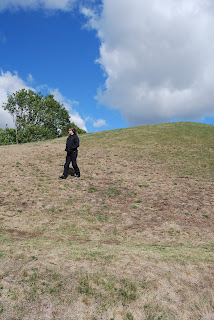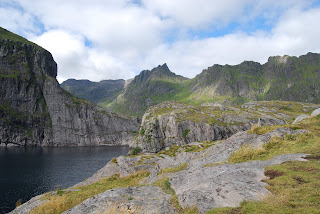Everyone says Sweden is
flat and boring. No, really they do. Everyone. Well we just had to go
and see for ourselves. One thing we did notice very quickly was how
CHEAP Sweden is - when compared to Norway. Petrol in Norway was
between £1.60 and £1.80 a litre. In Sweden it's £1.45. Food in the
supermarkets in Norway was at least one and a half, if not twice, as
expensive as the UK. In Sweden it's only a little more than the UK.
And after nearly two
weeks of fjords and twisty roads it was almost exciting to be on
reasonably straight road again. And I wouldn't say it was boring, not
when you've reindeer to look out for.
There should be photos
of reindeer now but we only actually saw them twice and didn't get
the camera out on either occasion. Tracy did manage to buy part of
one to sit on...
Near Kiruna we went to
'The Ice Hotel'. The world's first, it's been around for 20 years
although, of course, it's different ice every year. They harvest the
ice in the winter, store it in a big fridge, cut it and create the
hotel every October. Come April they just let it melt.
 |
| Blocks of ice in a -5C warehouse |
 |
| Cutting machine |
 |
| Frozen time |
 |
| No comment |
They even had a
motorcycle in ice!
South to Jokkmokk
(great name isn't it) and the wonderfully informative Sami Museum
where we learnt everything we would ever need to know about the Sami
people and reindeer.
And then on to the
coast and the Baltic Sea. We hit the coast at Lulea and visited
'Gammelstad' (once we could find it – but that's another story).
Unesco World Heritage listed, this place was the centre of Northern
Sweden in the Middle Ages. (I have to tell my students that they
didn't call it the Middle Ages during the Middle Ages. They just
called it 'now'.)
Incidentally, we stayed
in a hostel in Lulea. £50 a night and it looked like this, just in
case you were interested in what a Scandinavian hostel looks like.
 |
| Room cost £50 |
 |
| Well stocked kitchen - even had a TV! |
Just us and a dozen
Estonian labourers. Tracy turned the microwave on and the TV came on.
It was the first time we'd seen a TV in our whole trip, just over a
month. It was quite weird really to be travelling in western Europe
but not to see TV for so long. In other parts of the world a TV comes
as obligatory in every hotel/motel/hospedaje. Anyway, back to
Gammlstad.
The stone church
(1492), 424 wooden houses and six church stables remain. This is an
authentic Scandinavian church village. Due to the weather, climate
and terrain it was hard for peasants in outlying areas to attend
church every week so they built a village which would accommodate
churchgoers. People came to the village and stayed in the houses over
the weekend. On Mondays they went back to their villages (a medium
sized medieval Swedish village was said to be home to maybe 60 souls)
and the red houses in Gammelstad remained empty until Friday.
 |
| A photo of a photo but the best way to see what I mean |
The other interesting
thing about this place was that it used to be on the coast. Now it
isn't. This is due to post-glacial uplift. 20,000 years ago – our
last ice age – Britain was under 500 metres of ice. This part of
Scandinavia was under 3,000 metres. That weight of ice depressed the
earth. By the time the ice finally vanished, 10,000 years ago, the
crust had already risen 500 metres back towards its original
elevation and it's still rising. At first the uplift was fast but now
it has slowed to about 8mm a year. Gammelstad is now 10 metres higher
than it was 1,000 years ago. And in 2,000 years a land bridge may
well have formed across the Baltic to Finland.
Oh and I nearly forgot. We walked round the place at 10 am. No problem, no one else around. But as we were leaving a few police and security started turning up. The Swedish King and Queen were due at 2 pm. We couldn't quite believe the LACK of security. In the UK if the Queen visits somewhere bins are taken away, manhole covers are sealed days beforehand.
Further south this has
created what is know as Hoga Kusten, 'The High Coast'. Apparently the
world's highest shoreline at 286 metres above sea level. We went to
take a look.
It certainly was
strange to be stood on top of a 300 metre hill and realise that we
were in fact stood on what was a small island 10,000 years ago. 8 mm
a year might not sound much but it equates to nearly 40 cm in my
lifetime. Pretty fast geologically speaking.
 |
| That small island only 'appeared' a thousand years ago. |
 |
| Tracy contemplating the wonder that is Geology. |
Oh, and we crossed the
Arctic circle.
I hadn't been aware that the cirlce actually moves. Over a 40,000 year period it moves 180KM (I think) Something like that anyway.
South a bit more took
us on nice undulating (not flat and boring) roads to Umea.
Uninteresting in itself
we checked in to a rather expensive campsite which was little more
than a car park next to the coast. The evening was nice and warm but
clouds were brewing and it looked like it was going to rain....
I don't like waking up
in a tent to the sound of rain. It started at 6 a.m. And didn't look
like it was going to stop. Tracy's theory is, “If you wake up and
it's raining, go back to sleep until it isn't.” I tried but it just
got heavier.
At 9 am there was a
knock on the tent (if such a thing is possible). Alfio, the Italian
campsite owner who also ran the bakery next door was inviting us into
his bakery for breakfast!
Alfio gave us bread and
coffee and showed us around his bakery. He'd moved from Sicily to
Sweden in 1969 and told us his life story in his warm, dry
kitchenette as it continued to rain outside. He wouldn't let us go
until it had nearly stopped, continually checking the weather updates
on his phone. It was a wonderfully kind gesture of his, to look after
two wet campers on a cold rainy Saturday morning. We left Umea at
midday, dry and fed and happy, it could have been so different.
Just north of Stockholm
we stopped at Gamla Upsalla. Large burial mounds mark the graves
of....well, nobody knows. Sixth century cremated remains have been
found in the middle of the mounds but beyond that it's all
conjecture. Pre-Viking kings? Local chieftains? Or perhaps (suggested
by a 17th century professor) bizarrely the ancient
sunken
city of Atlantis???
The signs said "In order to preserve the mounds please don't walk on the paths" so Tracy is trying to walk down the mound without using the path. Harder than it sounds.
And so we wended our
way down to Stockholm. Sweden isn't flat or boring. Granted it isn't
as twisty and mountainous as Norway but then again it isn't as rainy
or expensive as Norway. It might not make my list of top ten
countries to visit but there's something there if you take a look.
I'd never have thought we'd have been to the world's highest
coastline and I didn't even know what a Swedish church village was a
week ago. And that, my friend, is what travelling should be about.






































































